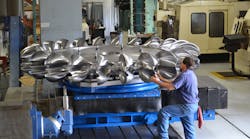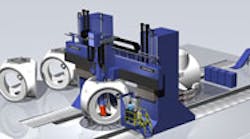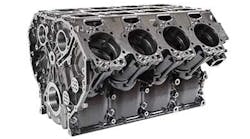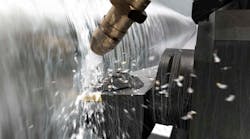Once upon a time in milling, manufacturing engineers and MRI managers regarded special tools as a last resort, limited mainly to dedicated high-volume applications. Conventional wisdom was that ‘specials’ cost too much, took too long to get, and raised too many risks, both technical and logistic.
That may have been true once — before the dominance of CAD/CAM, that is — but not anymore. Let's look at some recent cases.
Alert heat-exchanger builders are debottlenecking a tedious, but unavoidable tubesheet grooving operation with a modified standard Ingersoll double-grooving tool that does the job three times faster. Effectively, the tool increases plant capacity by 25%. Tooling costs dropped dramatically as well, since replacement involves only the carbide tip, not the entire tool.
In a small Faribault, Minn., job shop, where lot sizes average less than 100, a beefed-up Ingersoll indexable mill enabled MRG Tool and Die, to cut cycle time by 5 to 1 on a difficult, long-reach ID form milling job. Betting on repeat orders, MRG foreman Al Dietz invested in the modified standard tool to optimize the low lot-size operation from the outset.
In a virtually unmanned, five-axis CNC operation in Sumas, Wash., Canyon Hydro contour mills the buckets in 10-ton hydropower turbine rotors in half the time as before, using a modified Ingersoll button cutter that cuts as it retracts as well as when it advances. Previously, the undercutting required a separate operation on a separate spindle. The inserts are standard, only the cutter body was modified to accommodate additional inserts for the undercut.
In a more conventional, high-volume operation, a Midwest manufacturer of drivetrain components reduced tooling and labor costs by a total of $80,000 annually with a modified, standard Ingersoll tangential mill that finishes the throats in universal joint yokes, with a single pass. A special grind on standard inserts generates a curve on the bottom and special radii in the corners. The only change to the cutter is that it is size-matched to the width of the throat.
Modified standards fill critical niche
In each case the “specials” cost a little more than standard tools and pose no higher risk of failure. “We prefer to call them ‘modified standards’,” said Ingersoll Cutting Tools North American milling product manager Konrad Forman. “The tools are modifications to standard inserts or cutter bodies, not designed from scratch. In most cases it’s nothing more than a special grind on an off-the-shelf insert to create a special form.
“Sometimes it involves a special-size cutter or relocation of standard seat pockets to create the needed toolpath,” he continued. “They are 90% standard, so they’re 90% designed – and proven – from the get-go.”
Forman added that for modified standard inserts, the price is based solely on batch quantity. “There is no added design charge. ‘Design’ is a matter of drop-downs in our standard CAD/CAM process. Today, 10 modified standard inserts will literally cost no more than ten standards.” The cost differential for modified special cutter bodies is higher because they typically are more like “one-off” purchases, he said.
Ingersoll got its start in special milling tools, and has implemented fast-track processes to accelerate product development, like an engineering team dedicated to serving that niche more effectively. Even today, about half of Ingersoll’s milling business involves modified standards. Delivery is a matter of manufacturing queues only; no delays for design or testing.
Debottlenecking in an industry playing "catch-up"
The tubesheet slotting applications illustrate the strategic impact that a modified standard tool can make: it clears a real “bottleneck” operation in an industry that’s struggling to keep up with the fast-growing alternate energy market. Without heat exchangers, all process and thermal power-gen plants would grind to a standstill.
Canyon Hydro mounted a modified standard Ingersoll button cutter on a 19-inch extension, Sometimes working like a T-slotter, it a accomplishes a long-reach cutting task and eliminates the need to involve a separate spindle
Here is where the bottleneck develops: the tube sheet in a medium-size ASME heat exchanger might have 200 to
1,000 three-quarter-inch holes, each one requiring two grooves to facilitate a subsequent swaging operation. It has been estimated that a two-thirds cycle time saving for this single operation might increase the effective capacity of a heat exchanger shop by 25%.
The standard practice is based on a single-groove slotter made of solid carbide, which typically takes about 18 seconds to complete a pair of grooves. As it wears, it starts to throw burrs that must be removed by hand.
Ingersoll solved the problem by grinding the double-groove form into a standard four-flute, Chipsurfer replaceable-tip milling tool. Both shank and replaceable tip are carbide. The result is a three-to-one cycle time reuction, 25% plant capacity increase, 30% tool-life extension, and burrs and deburring completely eliminated. Moreover, the tool is much less expensive than the previous solid-carbide tool because the replaceable part represents less than 10% of all the carbide in the tool.
Replaceable-tip tool
“Because the replaceable tip is so easy to modify, uses so little carbide, and comes in such a variety of standard styles, the Chipsurfer has proven to be a great place to start when a modified standard milling tool is needed,” said Forman. “And repeatability is so good — 0.0005 inches radially — that tips can be changed right in the spindle, and the operation restarted immediately.”
Modified standard Chipsurfers have been proven in hundreds of applications, especially in keyslots and small-arms manufacturing, Forman added. Unlike tubesheet grooving, most of these applications require the less-expensive alloy steel shank.
Even though the MRG application also involved internal grooving, foreman Al Dietz faced a completely different problem than the shops producing heat exchangers. For one thing, the tube diameter is 19 inches, not 0.75. For another, the initial lot size was only 100 pc, and from a new customer. The workpiece becomes part of the kingpost assembly in a mining machine.
“I couldn’t justify a custom cutter for a single 100-piece order, but in this case I wanted to score points with a new customer that would diversify our market base,” Dietz explained.
What makes the job so difficult is the requirement to mill three 1-inch diameter ball bearing raceways into the ID, one of them seven inches deep inside the tube. “Long reach, ID milling, form milling: any single element by itself would be a challenge,” said Dietz. “Here we’ve got all three. It’s a machining ‘perfect storm’.”
Dietz ran the first lot with conventional HSS tools because it was a rush job and the tools were readily available. They burned up, they chattered, they ruptured, they took 12 hours to complete one set of three raceways, but MRG delivered the first order on time anyway.
While that was running, Dietz asked Ingersoll’s Ondrej Lubinski for an indexable carbide solution. The answer was an indexable button mill with an extra thick shank and extra large inserts, size matched to the raceway. Essentially, it was a very robust form tool. Dietz told the customer what he was doing so things would go better next time.
“The extra-thick shaft added much-needed rigidity to a long-reach form milling operation, which generates very large lateral cutting forces,” Lubinski explained.
Dietz’s initiative paid off. MRG got the repeat order, completing the three races in less than two hours. Inserts lasted through several pieces, wearing gradually, with no incidence of rupture.
“Because both the shank and insert pocket sizes were custom, lead time for the cutter was necessarily longer,” said Lubinski. “Nevertheless, the cutter will pay for itself out of savings with the next re-order.”
Actually, Dietz was surprised by the low cost and quick delivery of such a non-standard tool. “There’s a lot more metal in it for rigidity, but it cost us only 25% more than a standard grooving cutter and arrived just three weeks after we signed off on the design.”
Hydropower bucket list
Canyon Hydro’s key machining challenge is to contour mill the buckets on ten-ton hydropower turbine rotors, called “runners.” Completing a runner typically takes months of continuous five-axis, long-reach milling, much of it undercuts, leaving behind a ton and a half of chips. Virtually all the milling is done on 19-inch shank extensions. Nevertheless final surfaces must be smoother than 32µ and dimensionally correct within 0.010 inch.
“Cycle time savings are really secondary to repeatable accuracy in an unattended environment,” said Canyon Hydro manufacturing engineer Mike Hansen.
Hansen specified standard tools in his RFPs, but most vendors proposed a palette of specials anyway, and asked for up-front development money. The only exception was Ingersoll, which proposed a 2-inch ball mill for 90% or the milling, and a modified standard Form Master button cutter for the undercuts. The only modification is to add inserts on the backside of the cutter body to handle those undercuts. The cutter works like a standard button cutter most of the time, and then like a T-slotter when it reaches the undercut portion along the outer edge of each bucket.
Hansen runs the cutters at full speed during the day when the place is manned, and backs off the feed about 10% during the unmanned shifts as a precaution. In all cases the inserts last long enough for absolute process security for 12-15 hours at full speed; some last 45 hours in the cut per edge.
Machining the throats in 4140 steel universal-joint yokes presents a lot of challenges. It requires close tolerances plus a fine finish with special corner radii to minimize stress-raisers — in an alloy that has a bad habit of work hardening.
Customarily the throats are milled out in a two-step rough-finish process, involving two different facemills making multiple overlapping passes. Most high-volume manufacturers strongly prefer standard tools to maintain supply-chain flexibility.
One manufacturer broke the mold, opting for a modified standard facemill that does the entire job in a single pass: a size-matched Ingersoll tangential facemill. One pass completes the throat to exact width and depth. Custom curves ground into standard inserts generate the required corner radii.
As a result, the Canyon Hydro saves about $80,000 annually without upping the material removal rate. The savings stem completely from reduced tooling inventory, recapturing dead machine time and lowering tool servicing costs because the inserts last 10 times longer than before.
“Normally, we’d prefer standard tooling to maintain multi-source flexibility,” said the lead manufacturing engineer, “but here the benefits far outweighed the risks. After all, the tools are 90% standard, then tweaked for our specific need, and come from a mainline supplier that maintains large stocks. The tools work like a standard all the way through the supply chain — even in our vending machines – so I’m not really worried about surety of supply.”
“Back in the day, there were really only two choices in tooling: standard or special,” said Ingersoll’s Konrad Forman, “and now there’s a solid third: the modified standard. A slight modification to an otherwise standard tool can trigger a huge productivity gain with none of the baggage of traditional specials.”










